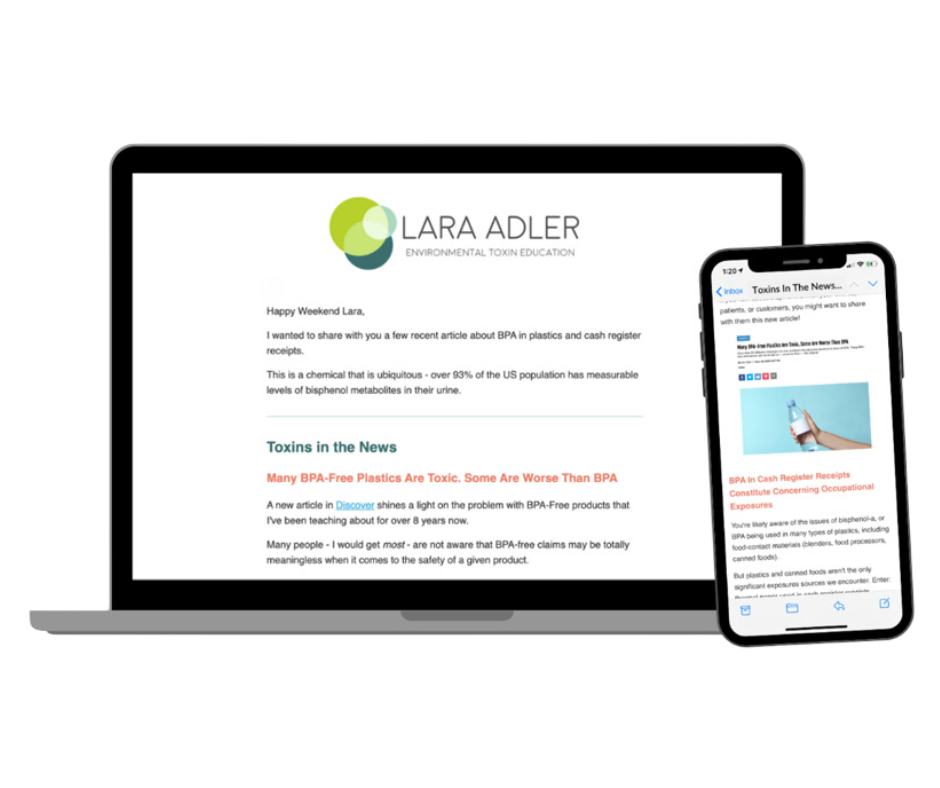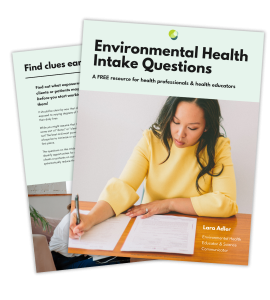Okay, so the title of this post seems like a bit of a stretch, right? Because you’re probably thinking that I’m talking about blending up pints of ice cream up the Vitamix and eating those day in and day out. While that might certainly cause you to gain a couple extra pounds, that’s actually not what I’m talking about at all.
In fact, I’m not talking about what you put in your blender, but rather, what your blender is made of. In the health coaching and health & wellness world in general, the Vitamix (or Blendtec, if you bend that way) reigns supreme! I don’t think I know very many heath coaches that don’t have one. But here’s the rub: The Vitamix & Blendtec blender carafes are made of a specific type of plastic – a clear, hard, and shatter resistant plastic called polycarbonate. Lots of things are made of polycarbonate plastic, from some types of baby bottles, food processor bowls, and water bottles… even your Brita water pitcher.
Polycarbonate plastic is made with a chemical that you’ve probably heard of before – BPA or Bisphenol-A. BPA has been around since the early 1890’s, but it wasn’t until the 1930’s that scientists discovered that BPA was a synthetic estrogen. In fact, for a little while, BPA was actually used in pharmaceuticals as a hormone replacement until it was replaced by DES (Diethylstilbestrol), which was a much more potent synthetic estrogen (and which has a much darker history than BPA!).
Since the 1940’s BPA has been used in thousands of plastic products – not only in the clear hard kinds like a blender carafe, but in the lining of metal cans, in dental sealants, and even in cash register receipts.
So how can BPA make us fat?
As a synthetic estrogen, or “endocrine disrupting chemical” (EDC), BPA is capable of interfering with normal function of the endocrine system by affecting the balanced system of glands and hormones that regulate vital body functions including growth, stress response, production and utilization of insulin, and metabolic rate, among other things. The most risky time for exposure that can determine whether we’re one of those people who struggles with weight or not as an adult is actually in the womb! Prenatal exposures can predispose people to gain weight in adolescence and adulthood, leading to insulin resistance, diabetes, and obesity. Yikes.
But even if you’re not in the womb, doesn’t make much sense to be ingesting chemicals that are capable of fiddling with the super delicate thermostat that your endocrine system is. Remember that our endocrine system regulates all those important body functions, one of which is metabolic rate. Mess with that too much and it won’t really matter how well you eat!
Funny thing is, when it comes to our Vitamix or Blendtec blenders we’re often using these partly to avoid those extra pounds – we pack them full of good, healthy veggies and fruits. This is a GOOD thing. We want to keep doing this for sure. But what about the BPA in the blenders? And what about the brand new BPA-FREE carafe that Vitamix recently released?
That’s a slightly longer discussion – one I’m going to be having very very soon – so stay tuned for more details on that! For now, I’ll just say that you should keep using your Vitamix, and not be fearful of it. BPA and a whole family of other endocrine disrupting chemicals are floating around your home (and your body, and your clients bodies) – let’s tackle those first! (watch this space for a special announcement later this week!!)




Hi Lara, thanks for this post! When I purchased my Blendtec last year, I read that my four-sided jar was BPA free. Is there some kind of loop hole here that allows for smaller amounts of BPA to be used, while still labeling products as free of BPA? Or, is it just not policed so BPA is found in products regardless of labeling? I’d love your insight on this to pass along to my clients and friends.
Hi Lee,
Not so much a loophole as very little to no regulation. BPA-FREE is not a legal requirement…it’s a voluntary move by manufacturers to appeal to consumer’s (founded) fears of BPA exposure. The problem is that BPA is just *one* kind of bisphenol – there are others that are often used as replacements, like BPF or BPS, and these also exhibit similar estrogenic activity.
So as we rush to demonize one chemical (BPA) we rarely pause to consider what they’re replacing it with.
Oh no! I just bought a Vita this weekend 🙁
Hi Lara,
My, what a lovely name!
Don’t fret… chances are that whatever you’re putting INTO the vitamix is healthy and nutritious. My motto is “changing the things we can control, so we can worry less about the ones we can’t”. Vitamix blenders would fall into the “can’t” category, so instead we work to eliminate or reduce exposure elsewhere in the home!
Hi Lara, Thanks for the post! I was wondering if you knew how long BPA can leach from plastics. I read somewhere that most plastics only leach BPA for a year or so, but don’t know if that’s true on not. If you have an answer please let me know! My Vitamix is 3 years old 🙂
My next question is: Do you know how long it takes for BPA to leach into plastics once food comes in contact? I am sure it depends on how acidic the food it, however I am only blending for a short time does BPA really get into my smoothie within a minute?
Thanks!
I also have the same question about leeching. Does the Vitamix continously leech plastic or does it only happen with specific foods or if you leave stuff in there a long time or with hot water of acidic stuff? I would love some details about the actually leeching. The amounts are small I am guessing but probably add up. Thanks.
Hi Angela,
This is a really great question. My understanding is that yes, these types of plastics continuously leech BPA and other similar compounds. I’ll likely write a follow-up blog post explaining this issue further, but for now, there are 4 things that increase the rate at which things like BPA migrate out, and that’s Heat, Oil, Acidity, and Abrasion. Unless you’re putting hot, oily, acidic foods into your vitamix, you’re likely not going to see significant levels leeching out. Also, the food is not being stored in the vitamix – it’s likely only in there for a minute or two.
SO yes, the amounts are small, but that’s actually a bigger issue than if the amounts were large. BPA and similar chemicals are synthetic estrogens – capable of blocking or mimicking natural estrogen in the body. Our hormonal system was designed to be responsive to minute levels – in the parts per trillion range – in the human body. Large chemical exposures to things like this sort of drown out the hormone receptors, and they just shut down, whereas small amounts – what your body is used to – can have a much much bigger impact. This is why BPA and other synthetic estrogens are connected to so many health issues – precisely because the doses are so small.
Cutting out synthetic estrogens elsewhere in the home is the best way – and being mindful of what you put in, and how you wash your vitamix is the best we can do at this time. They used to make a stainless steel carafe for their bases, and I wish they would bring those back, but until they do we just need to be mindful.
Hi Lara,
Thanks for this lovely post. I was looking on information on the safety of the Blendtec because my husband just got me one for my birthday. However, when I saw that the box was labeled PBA free I immediately got concerned. I am not sure if I want to keep the blender or just return it and wait until Vitamix comes back with the stainless steel crafe as, from what I understand, many have been requesting the switch back. I know you say that we should just be mindful of where else we are coming into contact with BPA, but you also say that it is the small amounts of contact that we should be concerned with. So, I’m still stuck as to what to do. Help please? And thanks for helping to explain these things to us all.
Hi Sigrid,
I totally hear you – it’s kind of a tricky decision! Until Vitamix brings back their stainless steel carafe, which I have no idea if they have any intention of doing, we’re stuck between using a BPA/BPS plastic blender that’s super powerful, or a less powerful blender with a glass carafe. Cuisinart I believe still makes a blender with a glass carafe, but in terms of power and function, it’s certainly no Blendtec or Vitamix.
My thoughts are this: The super healthy foods you’re likely going to be putting into your Blendtec are going to be a healthy and important addition to your diet. A big part of “detoxing” from all these chemicals is making sure the body is working at full capacity to allow as many of these toxins to come out as possible. Foods that are supportive of that goal – that are supportive of your detox organs – liver, kidney, etc, are critical. We can’t “detox” without them.
It’s impossible for us to ever reach a place of being 100% toxin free… we can make ourselves crazy trying to get there ( I refer to this as being “detoxorexic”), but we do take control where we can. I wish I had a better, more specific answer for you, but I don’t. We do the best we can. I have a Vitamix (and it’s not even a BPA-Free one!) and I use it almost daily. I choose just be very careful with how I wash and use it (no hot, oily foods go into my vitamix and I had wash with luke warm water and a soft sponge, rather than a scrubby one), but I do use it!
If you think having the Blendtec will help you to eat better, more health supportive foods, then it’s a good thing 🙂
I have an original stainless steel Vita-Mix. I also have the newer polycarbonate model.
The problem is that the lids for the old model are no longer available, so my old steel
container sprays all over when in use. My lid is damaged and I can’t even get a gasket 🙁
Hi Christine – That is a major bummer! Check ebay out – I saw all kinds of old stainless vitamix items for sale there when I checked last – sometimes you need adapters since the design has changed over the years, but you might be able to find a replacement lid 🙂
Hi Lara
Why is there no vitamix with glascontainer?
As far as I know stainless steel is also not the best for our bodies.
I normally use iron for cooking boiled food and my old blender has a glascontainer.
Is there any problems with glas(apart from breakable and heavy)?
Looking forward to an ansver and the continuation of the talk around the new BPA-free vitamix.
Many thanks, I have been attempting to find info regarding this subject matter for ages and
yours is the greatest I have found thus far.